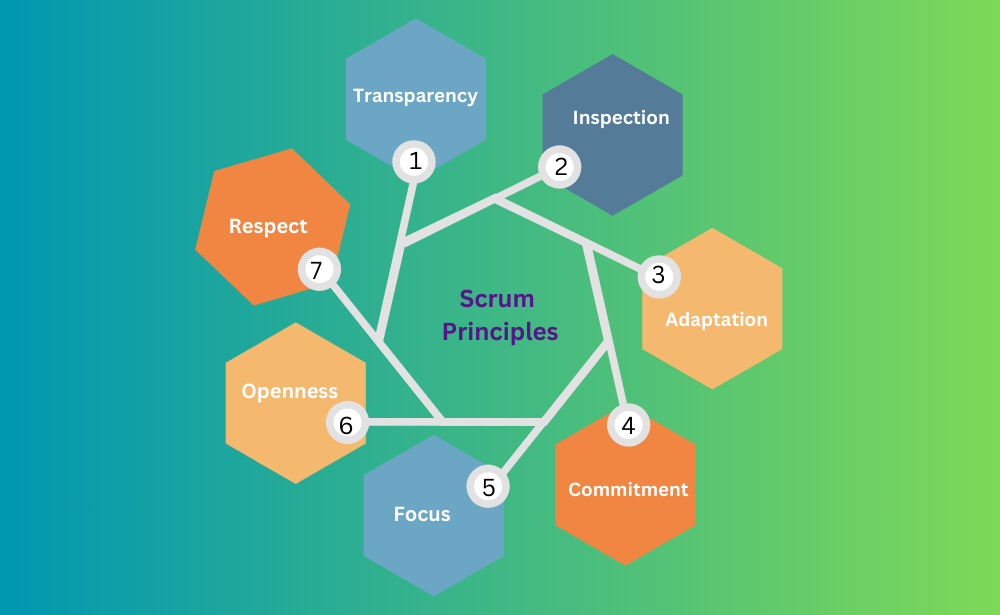
Introduction
Scrum is a popular Agile framework that has transformed how teams approach project management and software development. By applying Scrum principles effectively, teams can significantly improve their project outcomes. In this blog, we’ll explore how you can leverage Scrum principles to enhance productivity, collaboration, and the quality of deliverables.
Principle 1: Transparency
Definition:
Transparency means making all aspects of the Scrum process visible to everyone involved. This visibility ensures that all stakeholders have a shared understanding of the project’s progress and any issues that may arise.
Application:
- Sprint Backlog: Keep the Sprint Backlog accessible and updated. This allows all team members and stakeholders to see what tasks are being worked on and their status.
- Daily Standups: Conduct daily standup meetings where team members share their progress and any obstacles they face. This enhances transparency and facilitates rapid problem-solving.
- Sprint Review: Hold regular Sprint Reviews to showcase completed work to stakeholders. This helps maintain transparency about what has been accomplished and what remains to be done.
Principle 2: Inspection
Definition:
Inspection involves regularly checking Scrum artifacts and progress towards the Sprint Goal to identify any deviations or issues.
Application:
- Daily Standups: Use daily standup meetings to inspect the progress of each team member and identify any impediments.
- Sprint Review: Inspect the completed work during the Sprint Review meeting to gather feedback and ensure it meets the desired standards.
- Retrospectives: Conduct Sprint Retrospectives to inspect team processes and behaviors. This helps pinpoint areas for improvement and cultivates a culture of continuous learning.
Principle 3: Adaptation
Definition:
Adaptation means making adjustments to processes or practices based on the results of inspections. This ensures that the team can address any issues promptly and improve continuously.
Application:
- Sprint Planning: Adapt the Sprint Backlog based on the outcomes of the previous Sprint and any changes in priorities.
- Daily Standups: Make daily adjustments to the team’s work plan based on the latest information and progress.
- Retrospectives: Implement actionable improvements identified during Sprint Retrospectives to enhance future Sprints.
Principle 4: Commitment
Definition:
Commitment refers to the dedication of the Scrum team to achieving their goals and delivering high-quality work.
Application:
- Sprint Goals: Define clear and achievable Sprint Goals that guide the team’s efforts and focus.
- Team Collaboration: Foster a culture of commitment where team members support each other and work collaboratively towards common objectives.
- Accountability: Encourage team members to take ownership of their tasks and be accountable for their contributions to the team’s success.
Principle 5: Focus
Definition:
Focus means that all team members concentrate on the work of the Sprint and the goals of the Scrum Team.
Application:
- Sprint Planning: Prioritize the most important tasks and focus on delivering them within the Sprint.
- Daily Standups: Use daily meetings to ensure the team remains focused on their goals and addresses any distractions.
- Shielding from Interruptions: The Scrum Master helps to protect the team from external interruptions, allowing them to concentrate on their work.
Principle 6: Openness
Definition:
Openness involves creating an environment where team members feel free to express their thoughts, concerns, and ideas.
Application:
- Feedback: Encourage open and honest feedback during Sprint Reviews and Retrospectives.
- Communication: Promote open communication within the team to ensure everyone is aware of progress and any issues.
- Trust: Build a culture of trust where team members feel comfortable sharing their challenges and successes.
Principle 7: Respect
Definition:
Respect means that team members respect each other’s skills, experience, and insights.
Application:
- Collaboration: Foster respectful collaboration where all voices are heard and valued.
- Conflict Resolution: Address conflicts constructively and respectfully to maintain a positive team environment.
- Acknowledgment: Recognize and appreciate the contributions of all team members.
Conclusion
Applying Scrum principles effectively can greatly enhance project outcomes by fostering a culture of transparency, inspection, adaptation, commitment, focus, openness, and respect. By embracing these principles, Scrum teams can improve their processes, deliver high-quality products, and achieve their project goals more efficiently. Start implementing these principles today to see a significant positive impact on your projects.